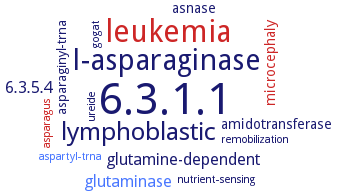6.3.1.1: aspartate-ammonia ligase
This is an abbreviated version!
For detailed information about aspartate-ammonia ligase, go to the full flat file.

Word Map on EC 6.3.1.1 
-
6.3.1.1
-
leukemia
-
l-asparaginase
-
lymphoblastic
-
glutamine-dependent
-
6.3.5.4
-
glutaminase
-
amidotransferase
-
microcephaly
-
asnase
-
asparaginyl-trna
-
gogat
-
nutrient-sensing
-
remobilization
-
ureide
-
aspartyl-trna
-
asparagus
- 6.3.1.1
- leukemia
- l-asparaginase
- lymphoblastic
-
glutamine-dependent
-
6.3.5.4
- glutaminase
-
amidotransferase
- microcephaly
- asnase
-
asparaginyl-trna
- gogat
-
nutrient-sensing
-
remobilization
-
ureide
- aspartyl-trna
- asparagus
Reaction
Synonyms
ammonia-dependent ASNS, ammonia-dependent asparagine synthetase, AS-A, AS-AR, AsnA, ASNS, Asparagine synthetase, Asparagine synthetase A, asparagine synthetase, ammonia-dependent, L-Asparagine synthetase, NH4+-dependent asparagine synthetase, Synthetase, asparagine, Tb927.6.1880, TbASNA
ECTree
Advanced search results
Cloned
Cloned on EC 6.3.1.1 - aspartate-ammonia ligase
Please wait a moment until all data is loaded. This message will disappear when all data is loaded.
bacterial gene is placed under control of light-dependent promoters, and introduced by transformation into Lotus corniculatus plants. The asnA-expressing plants are characterized by premature flowering and reduced growth. Transformation with asnA also induces a significant reduction of photosynthesis when measured under saturated light and ambient CO2 conditions
-
expression of Escherichia coli asnA gene in Brassica napus could be of advantage at high N supply, but not at limiting N ´fertilizer supply
-
gene Tb927.6.1880, recombinant expression of N-terminally His6-tagged enzyme in Escherichia coli strain BL21
quantitative enzyme expression analysis in Hep-G2 cells in absence or presence of UPR blockers and activators, transcription factor recruitment to the ASNS promoter during the UPR, transcriptional activation of UPR target genes is mediated by three signaling cascades PERK/eIF2alpha/ATF4, ATF6, and IRE1/XBP1, UPR activation does not trigger increased recruitment of Mediator subunits to the ASNS promoter, the IRE1/XBP1 and ATF6 branches of the UPR do not participate in the induction of ASNS transcription, overview
-
the enzyme is obtained by means of a plasmid, pUNAd37, a derivative of pUC18 in Escherichia coli. The plasmid is constructed by optimizing a DNA sequence between the promoter and the ribosome binding region
-


 results (
results ( results (
results ( top
top





